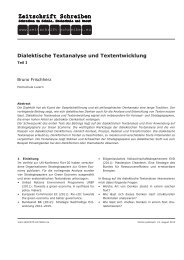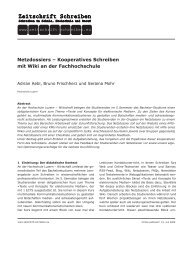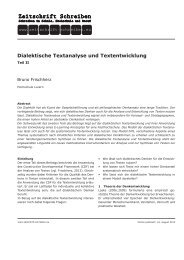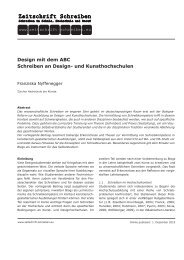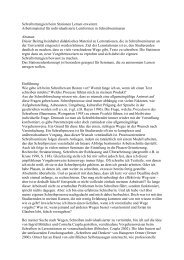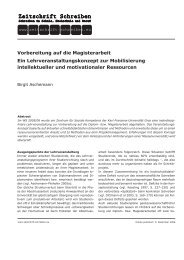Active Reading and the Teaching of Writing - Zeitschrift Schreiben
Active Reading and the Teaching of Writing - Zeitschrift Schreiben
Active Reading and the Teaching of Writing - Zeitschrift Schreiben
Create successful ePaper yourself
Turn your PDF publications into a flip-book with our unique Google optimized e-Paper software.
we can draw our attention to rhetorical figures (figures<br />
<strong>of</strong> speech), <strong>and</strong> we can guide our students not only to<br />
detect figures, trophes, <strong>and</strong> wordplays but also (<strong>and</strong><br />
above all) to underst<strong>and</strong> <strong>the</strong> relationship between text<br />
content <strong>and</strong> <strong>the</strong> use <strong>of</strong> stylistic effects. We can also<br />
teach our students to «unveil <strong>the</strong> author’s secrets» <strong>and</strong><br />
to underst<strong>and</strong> how an author can create a particular<br />
atmosphere <strong>and</strong> a particular effect on his readers using<br />
colour names or talking about sounds, smells (<strong>and</strong><br />
so on) <strong>and</strong> using synes<strong>the</strong>sias. This kind <strong>of</strong> analysis<br />
<strong>of</strong>fers also <strong>the</strong> opportunity to think about <strong>the</strong> difference<br />
between denotative <strong>and</strong> connotative meaning.<br />
Developing adult reading strategies<br />
In The psychology <strong>of</strong> written composition, Carl Bereiter<br />
<strong>and</strong> Marlene Scardamalia highlighted many differences<br />
between adult (expert) <strong>and</strong> young (inexpert) readers.<br />
We mentioned above Bonnie Meyer’s studies about text<br />
structure. Bereiter <strong>and</strong> Scardamalia mentioned Chuck<br />
Rieger’s researches too. In his studies Rieger noticed<br />
that in a text some words can have a special effect on<br />
readers because, for example, <strong>the</strong>y open a problem<br />
or make <strong>the</strong> reader curious about something. When a<br />
reader finds such a «key» word, his attention remains<br />
active until he, continuing to read, can find <strong>the</strong> answer<br />
he is looking for. 16 Fur<strong>the</strong>r studies confirmed that an<br />
active reader raises problems <strong>and</strong> formulates <strong>the</strong>sis<br />
during his reading activity <strong>and</strong>, analyzing <strong>the</strong> text, he<br />
looks for answers to problems <strong>and</strong> for confirmations to<br />
his <strong>the</strong>sis.<br />
Moreover, when an active reader finds an unknown word<br />
in <strong>the</strong> text (especially if it is a keyword <strong>of</strong> <strong>the</strong> text), he<br />
looks for an explanation <strong>of</strong> <strong>the</strong> word’s meaning in <strong>the</strong><br />
following parts <strong>of</strong> <strong>the</strong> text; or, when he notices that <strong>the</strong><br />
author makes a general statement in <strong>the</strong> text, he waits<br />
for examples <strong>and</strong> fur<strong>the</strong>r explanations in <strong>the</strong> following<br />
parts <strong>of</strong> <strong>the</strong> text. 17<br />
In <strong>the</strong>ir researches, Walter Kintsch <strong>and</strong> Teun Van<br />
Dijk affirmed <strong>the</strong> expert reader uses to construct a<br />
«macrostructure» <strong>of</strong> <strong>the</strong> text he is reading:<br />
Whole lists <strong>of</strong> propositions may be given arbitrary<br />
names, <strong>and</strong> <strong>the</strong>se names can likewise be linked by<br />
<strong>the</strong> symbol &. Each name can be exp<strong>and</strong>ed as a list<br />
<strong>of</strong> o<strong>the</strong>r names <strong>and</strong> eventually propositions. Thus,<br />
<strong>the</strong> macrostructure <strong>of</strong> a text can be recursively<br />
defined simply by combining propositions into<br />
ordered lists <strong>and</strong> <strong>the</strong>n constructing lists <strong>of</strong> lists,<br />
until <strong>the</strong> desired level <strong>of</strong> organization has been<br />
achieved. […] The macrostructure is something<br />
like an outline, using propositions or groups<br />
<strong>of</strong> propositions with an arbitrary name as <strong>the</strong><br />
elements <strong>of</strong> <strong>the</strong> outline. 18<br />
<strong>Reading</strong> problems <strong>and</strong> writing skills<br />
O<strong>the</strong>r studies are important to underst<strong>and</strong> what expert<br />
readers do when <strong>the</strong>y find a difficult passage <strong>of</strong> <strong>the</strong><br />
text. In particular, Bereiter <strong>and</strong> Bird found that both<br />
young <strong>and</strong> adult readers read again <strong>the</strong> passage when<br />
<strong>the</strong>y found it hard to underst<strong>and</strong>, but adult readers<br />
can highlight difficult points in a faster way than young<br />
ones. 19 Bereiter <strong>and</strong> Scardamalia affirmed that expert<br />
readers are more able than young ones to explain<br />
where <strong>and</strong> why <strong>the</strong>y encountered difficulties in text<br />
comprehension <strong>and</strong> so <strong>the</strong>y can faster find <strong>the</strong> solution<br />
to <strong>the</strong>ir comprehension problems. 20 In fact, every<br />
teacher can experience that if a student can say which<br />
is <strong>the</strong> hard-to-underst<strong>and</strong> point <strong>of</strong> <strong>the</strong> text (e. g., a<br />
difficult keyword, or lack <strong>of</strong> examples to illustrate a<br />
difficult concept); <strong>the</strong> solution <strong>of</strong> <strong>the</strong> problem can be<br />
found in an easier way than when <strong>the</strong> student says that<br />
«in general» <strong>the</strong> text is hard to underst<strong>and</strong>.<br />
Lee Odell, in a research about academic writing,<br />
highlighted <strong>the</strong> relationship between reader’s attitude<br />
towards comprehension problems <strong>and</strong> writing skills:<br />
I would argue that <strong>the</strong> ability to read <strong>and</strong> write<br />
sensitively, thoughtfully, <strong>and</strong> independently<br />
presupposes <strong>the</strong> ability to formulate <strong>and</strong> solve<br />
problems. […] Problems arise when an individual<br />
becomes aware <strong>of</strong> some dissonance <strong>and</strong> […]<br />
one’s ability to solve a problem depends in large<br />
part upon his ability to explore <strong>and</strong> revise his<br />
internal world, to examine data thoroughly, <strong>and</strong><br />
to reformulate <strong>the</strong> questions he poses. 21<br />
The use <strong>of</strong> comprehension questions<br />
In order to help our students to isolate difficult points<br />
<strong>of</strong> <strong>the</strong> texts <strong>the</strong>y study, we can propose comprehension<br />
questions that can be used in high school <strong>and</strong> in<br />
academic activity. Comprehension questions are useful<br />
not only to highlight significant information in a text,<br />
but can be used also to encourage students to draw<br />
inferences or to distinguish different author’s intentions<br />
in <strong>the</strong> same text. The effect <strong>of</strong> every question depends<br />
not only on its content, but on its position as well (we<br />
can propose pre-reading questions or post-reading<br />
ones) <strong>and</strong> on <strong>the</strong>ir frequency.<br />
Exercice 4. Open questions vs. Close questions<br />
Marinella Lizza: «<strong>Active</strong> <strong>Reading</strong> <strong>and</strong> <strong>the</strong> <strong>Teaching</strong> <strong>of</strong> <strong>Writing</strong>» www.zeitschrift-schreiben.eu 10.10.2007 Seite: /8



